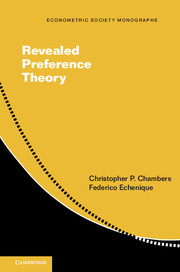Book contents
- Frontmatter
- Dedication
- Contents
- Preface
- 1 Mathematical Preliminaries
- 2 Classical Abstract Choice Theory
- 3 Rational Demand
- 4 Topics in Rational Demand
- 5 Practical Issues in Revealed Preference Analysis
- 6 Production
- 7 Stochastic Choice
- 8 Choice Under Uncertainty
- 9 General Equilibrium Theory
- 10 Game Theory
- 11 Social Choice and Political Science
- 12 Revealed Preference and Systems of Polynomial Inequalities
- 13 Revealed Preference and Model Theory
- References
- Index
- Miscellaneous Endmatter
4 - Topics in Rational Demand
Published online by Cambridge University Press: 05 January 2016
- Frontmatter
- Dedication
- Contents
- Preface
- 1 Mathematical Preliminaries
- 2 Classical Abstract Choice Theory
- 3 Rational Demand
- 4 Topics in Rational Demand
- 5 Practical Issues in Revealed Preference Analysis
- 6 Production
- 7 Stochastic Choice
- 8 Choice Under Uncertainty
- 9 General Equilibrium Theory
- 10 Game Theory
- 11 Social Choice and Political Science
- 12 Revealed Preference and Systems of Polynomial Inequalities
- 13 Revealed Preference and Model Theory
- References
- Index
- Miscellaneous Endmatter
Summary
Chapter 3 established the testable implications of the hypothesis that consumers are rational. We are often interested in situations where the rationalizing preference, or demand function, satisfies additional properties. We want to know what additional structure is imposed on a dataset from demanding that the rationalization has to use a utility function with some given property. In particular, we focus on the properties of supermodularity, submodularity, homotheticity, separability, complements, and substitutes.
DISCRETE GOODS: SUPERMODULAR AND SUBMODULAR RATIONALIZATIONS
In Chapter 3 we discussed a collection of results in the spirit of Afriat's Theorem. In these results, one obtains a concave rationalization from the rationalizability of the data. Arguably, though, most consumption goods come in discrete units. Some goods seem particularly “lumpy,” such as cars and houses. For such goods, the notion of concavity is not well defined. One can instead investigate super- and submodularity. Supermodularity corresponds to the notion that goods are complements: specifically, that increases in the consumption of one good become more valuable when one consumes more of the other goods. Submodularity corresponds to the property of substitute goods.
The meaning of super- and submodularity can be understood from Figure 4.1. In the figure, there are two goods. For any two bundles x and y, x ∧ y is the component-wise minimum of the bundles x and y, and x∨y is the component-wise maximum (see the definitions in Chapter 1). The function u : X→R is supermodular if for all x, y ∈ X,
and submodular if −u is supermodular.
If u is supermodular then the change in utility u(x)−u(x∧y) cannot exceed the change u(x∨y)−u(y). Note that in Figure 4.1, the increase in good 2 when we go from x∧y to x is the same as when we go from y to x∨y. This means that the change in utility resulting from adding the amount of good 2 in the change from x∧y to x, can only be larger when the quantity of good 1 is larger. This is a notion of complementary goods: the increases in utility due to increases in consumption of good 2 are larger as we consume more of good 1.
- Type
- Chapter
- Information
- Revealed Preference Theory , pp. 57 - 70Publisher: Cambridge University PressPrint publication year: 2016



